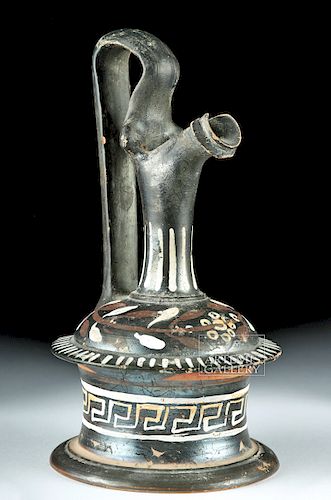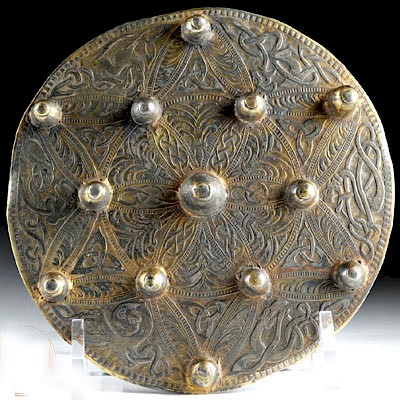Greek Gnathian Epychisis Vessel - Flowers & Greek Key
Lot 22
About Seller
Artemis Fine Arts
686 S Taylor Ave, Ste 106
Louisville, CO 80027
United States
Selling antiquities, ancient and ethnographic art online since 1993, Artemis Gallery specializes in Classical Antiquities (Egyptian, Greek, Roman, Near Eastern), Asian, Pre-Columbian, African / Tribal / Oceanographic art. Our extensive inventory includes pottery, stone, metal, wood, glass and textil...Read more
Estimate:
$900 - $1,400
Absentee vs Live bid
Two ways to bid:
- Leave a max absentee bid and the platform will bid on your behalf up to your maximum bid during the live auction.
- Bid live during the auction and your bids will be submitted real-time to the auctioneer.
Bid Increments
| Price | Bid Increment |
|---|---|
| $0 | $25 |
| $300 | $50 |
| $1,000 | $100 |
| $2,000 | $250 |
| $5,000 | $500 |
| $10,000 | $1,000 |
| $20,000 | $2,500 |
| $50,000 | $5,000 |
| $100,000 | $10,000 |
| $200,000 | $20,000 |
About Auction
By Artemis Fine Arts
Jul 19, 2018
Set Reminder
2018-07-19 10:00:00
2018-07-19 10:00:00
America/New_York
Bidsquare
Bidsquare : Fine Antiquities/Ethnographic Art
https://www.bidsquare.com/auctions/artemis-gallery/fine-antiquities-ethnographic-art-3329
Featuring classical antiquities, ancient and ethnographic art from cultures encompassing the globe, plus fine art. Artemis Fine Arts info@artemisgallery.com
Featuring classical antiquities, ancient and ethnographic art from cultures encompassing the globe, plus fine art. Artemis Fine Arts info@artemisgallery.com
- Lot Description
Magna Graecia, Southern Italy, Gnathian, ca. 4th century BCE. A classic South Italic example of an epychisis, a vessel for holding ointments and perfumes, with an incredible silvery patina. The vessel has a beautiful avian-form spout with eye-like attachments at the sides and a long, open, deeply-grooved, beak-like mouth. The tall strap handle rises from the back of the spout, then curves at an acute angle down to meet the shoulder. The body is round, almost reel-shaped, with a projecting rim underneath the shoulder and at the foot. A Greek key meander adorns the lower body, while lovely floral vines are painted on the shoulder in red, white, and yellow hues. Size: 6.875" H (17.5 cm)
This impressive decorative technique is typical for pottery which is commonly called Gnathian, after the name of present-day Egnazia (located on the Adriatic coast of Apulia). In the middle of the nineteenth century, pottery with this type of decoration was found during excavations of the cemeteries of Egnazia (and nearby Fasano). Ever since, it has been known as the pottery of Egnazia, or Gnathia pottery, even though not all of it was in fact made at Egnazia.
Literature: J. Richard Green, "Gnathia and Other Overpainted Wares of Italy and Sicily: a Survey", in Evelyne Geny (ed., sous la direction de Pierre Leveque et Jean-Paul Morel), Ceramiques Hellenistiques et Romaines III (Besancon, Presses Universitaires Franc-Comtoises, 2001), 57-103; J. Richard Green, "The Gnathia Pottery of Apulia ", in: Margaret Ellen Mayo - Kenneth Hamma (eds.), The Art of South Italy. Vases from Magna Graecia (Richmond, Virginia Museum of Fine Arts, 1982), p. 252-258.
Provenance: private East Coast, USA collection
All items legal to buy/sell under U.S. Statute covering cultural patrimony Code 2600, CHAPTER 14, and are guaranteed to be as described or your money back.
A Certificate of Authenticity will accompany all winning bids.
We ship worldwide and handle all shipping in-house for your convenience.
#135272Tip of spout has been reattached.Tiny nick to upper edge of spool-shaped body. The black glaze has developed a beautiful iridescence. Normal surface wear with areas of pigment loss, but most of the painted program is very well preserved.Condition
- Shipping Info
-
All shipping is handled in-house for your convenience. Your invoice from Artemis Gallery will include shipping calculation instructions. If in doubt, please inquire BEFORE bidding for estimated shipping costs for individual items.
-
- Buyer's Premium



 EUR
EUR CAD
CAD AUD
AUD GBP
GBP MXN
MXN HKD
HKD CNY
CNY MYR
MYR SEK
SEK SGD
SGD CHF
CHF THB
THB
















